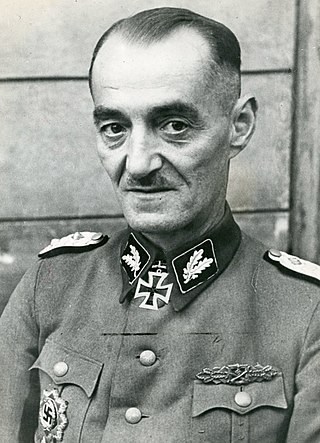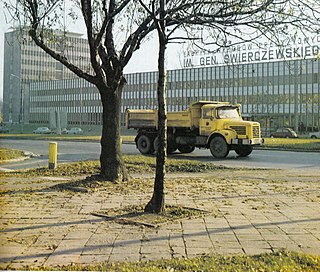
Schiffers & Co. was a silver manufacturer from Warsaw, Poland.

Schiffers & Co. was a silver manufacturer from Warsaw, Poland.
The company was founded in 1888 [1] by Andrzej Boleslaw Schiffers. At the beginning of the twentieth century, when the company joined John Salinger, the factory employed 100 workers, annual turnover was then 150,000 rubles. After World War I, employment decreased to about 50 employees. The company produced various crockery and silver goods of high quality.
PZL was the main Polish aerospace manufacturer of the interwar period, and a brand of their aircraft. Based in Warsaw between 1928 and 1939, PZL introduced a variety of well-regarded aircraft, most notably the PZL P.11 fighter, the PZL.23 Karaś light bomber, and the PZL.37 Łoś medium bomber.

Oskar Dirlewanger was a German military officer (SS-Oberführer) and convicted rapist known for committing numerous war crimes. He played a significant role as the founder and commander of the SS penal unit known as the "Dirlewanger" during World War II.

The Dirlewanger Brigade, also known as the SS-Sturmbrigade Dirlewanger (1944), or the 36th Waffen Grenadier Division of the SS, or The Black Hunters, was a unit of the Waffen-SS during World War II. The unit, named after its commander Oskar Dirlewanger, consisted of convicted criminals who were not expected to survive their service with the unit. Originally formed from convicted poachers in 1940 and first deployed for counter-insurgency duties against the Polish resistance movement, the brigade saw service in anti-partisan actions in German-occupied Eastern Europe.

The Silver Fleet is a 1943 British World War II film written and directed by Vernon Sewell and Gordon Wellesley and produced by Powell and Pressburger under the banner of "The Archers".

Royal Copenhagen, officially the Royal Porcelain Factory, is a Danish manufacturer of porcelain products and was founded in Copenhagen in 1775 under the protection of Danish Dowager Queen Juliane Marie. It is recognized by its factory mark, the three wavy lines above each other, symbolizing Denmark's three water ways: Storebælt, Lillebælt and Øresund.

Ursus SA is a Polish agricultural machinery manufacturer, headquartered in Lublin, Poland. The company was founded in Warsaw in 1893, and has strong historic roots regarding Polish tractor production history. It has also carried out some production of trolleybuses in a joint venture with the Ukrainian manufacturer Bogdan, and manufactures buses, coaches, and trolleybuses in a joint venture with AMZ Kutno under the name Ursus Bus.

The Yard-O-Led Pencil Company is a manufacturing company founded in London, England in 1934 by German immigrant, Ludwig Brenner, to produce his patent propelling pencils which contained twelve three inch leads. After World War II the company merged with Sampson Mordan Ltd whose founder had patented the first mechanical pencil in 1822. They built a new factory in Birmingham and took over Edward Baker Ltd, another pencil maker.

Michał Klepfisz was a chemical engineer, activist for the Bund, and member of the Jewish Morgenstern sports organization. During World War II he belonged to the Jewish Combat Organization, fighting the Nazi German forces in Poland. He was killed in the Warsaw Ghetto Uprising and was posthumously decorated by the Polish government in exile with a Silver Cross of the Virtuti Militari.

E. Wedel is a Polish confectionery company, which has been producing a variety of chocolates, cakes, and snacks since 1851. Wedel is also a well-recognized brand of candy in Poland, considered to be the "Polish national chocolate brand" in that market, and is the leading candy brand among Polish producers, with about 14% of the Polish market in 2005, and 11.7% in 2007.

The F.W. Smith Silver Company is a historic factory building at 60 Chestnut Street in Gardner, Massachusetts. It was built in 1892 by Frank W. Smith, who had begun manufacturing sterling silver silverware in 1886. The business continued under a succession of owners until 1958. The building is locally distinguished for its late Victorian commercial style, including a tower with pyramidal roof, and stained glass windows. The building was listed on the National Register of Historic Places in 1979.

Haviland & Co. is a manufacturer of Limoges porcelain in France, begun in the 1840s by the American Haviland family, importers of porcelain to the US, which has always been the main market. Its finest period is generally accepted to be the late 19th century, when it tracked wider artistic styles in innovative designs in porcelain, as well as stoneware and sometimes other ceramics.

Bing & Grøndahl was a Danish porcelain manufacturer founded in 1853 by the sculptor Frederik Vilhelm Grøndahl and merchant brothers Meyer Hermann Bing and Jacob Herman Bing. The trademark backstamp for Bing & Grøndahl (B&G) porcelains is the three towers derived from the Coat of Arms of Copenhagen. The company's Seagull dinnerware series became known as the "National Service of Denmark" in the 1950s when it was found in one tenth of all Danish households. In 1987 the company merged with its primary competitor, the Royal Porcelain Factory under the name Royal Copenhagen.

California pottery includes industrial, commercial, and decorative pottery produced in the Northern California and Southern California regions of the U.S. state of California. Production includes brick, sewer pipe, architectural terra cotta, tile, garden ware, tableware, kitchenware, art ware, figurines, giftware, and ceramics for industrial use. Ceramics include terra cotta, earthenware, porcelain, and stoneware products.

Państwowa Fabryka Karabinów was a Polish arms manufacturer active between the two World Wars. Founded in 1919 as the successor to the pre-World War I Gerlach i Pulst company, Fabryka Karabinów became part of the state-owned Państwowe Wytwórnie Uzbrojenia conglomerate in 1927. It was a sister company to Łucznik Arms Factory, the Munitions Factory of Skarżysko, and several others. By the end of the 1930s, Fabryka Karabinów was one of the largest arms producers of Poland. It was destroyed during World War II. Nationalized after the war and with a new focus on civilian precision tools, it was renamed as VIS after 1989, but liquidated in the early 21st century.

Verbrennungskommando Warschau was a slave labour unit formed by the SS following the Wola massacre of around 40,000 to 50,000 Polish civilians by the Germans in the early days of the Warsaw Uprising of 1944.

K. Rudzki i S-ka was a Polish engineering and machinery company. Founded in Warsaw in 1858 as an iron foundry by a shipbuilding magnate Andrzej Artur Zamoyski and led by Konstanty Rudzki, it soon expanded into machinery, steel and engineering. By the end of the 19th century the company, with its seat in Warsaw and a large factory in Mińsk Mazowiecki, had become one of the largest and most experienced bridge construction contractors in Central and Eastern Europe, with roughly 20% of bridges constructed in the Russian Empire bearing the logo of K. Rudzki. After World War I the company declined and ceased its machinery production arm, but continued on as an engineering and construction business. It was nationalised and liquidated after World War II.

Lilpop, Rau i Loewenstein was a Polish engineering company. Established in 1818 as an iron foundry, with time it rose to become a large holding company specialising in iron and steel production, as well as all sorts of machinery and metal products.

Pairpoint Glass Company is an American glass manufacturer based in Sagamore, Massachusetts. It is currently the oldest operating glass company in the United States.

Stanisław Witkowski CBE (Hon.), was an officer, engineer and military industry organiser in the Polish Army, Hononary Commander of the Order of the British Empire.

The William B. Durgin Company was a noted American sterling silver manufacturer based in Concord, New Hampshire, and one of the largest flatware and hollowware manufacturers in the United States. Over the period 1905-1924 it was merged into the Gorham Manufacturing Company.
![]() Media related to Schiffers & Co. at Wikimedia Commons
Media related to Schiffers & Co. at Wikimedia Commons